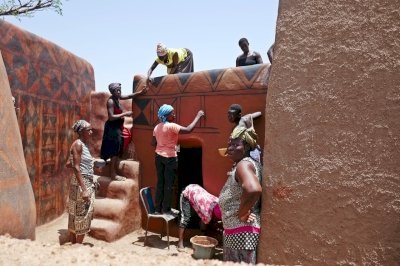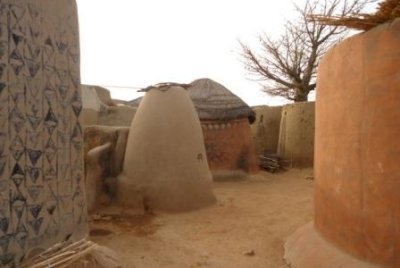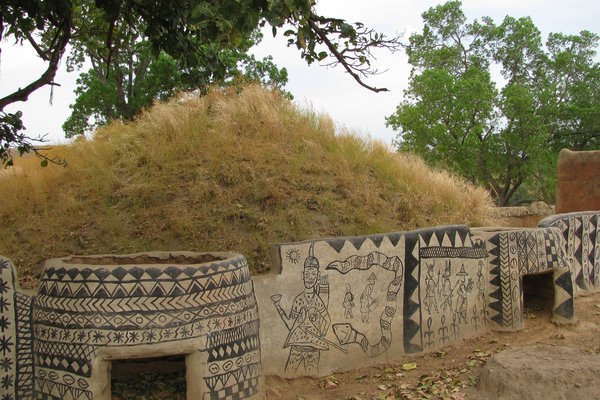Burkina Faso
The Royal Court of Tiébélé
The Royal Court of Tiébélé represents a form of vernacular architecture and traditions from the 16th century.
It comprises a large compound of painted houses, which are traditionally decorated by the women. The buildings are made of earth, wood and straw.
Community Perspective: This small compound is easily accessible by public transport from nearby Po (Jarek) or by 4h taxi from Ouagadougou (Ammon). There's an entrance fee and an obligatory guide, though the site doesn't seem to be maintained well.
Site Info
Official Information
- Full Name
- The Royal Court of Tiébélé (ID: 1713)
- Country
- Burkina Faso
- Status
-
Inscribed 2024
Site history
History of The Royal Court of Tiébélé
- 2024: Inscribed
- Inscribed
- Type
- Cultural
- Criteria
- iii
Links
- UNESCO
- whc.unesco.org
- Related
-
- craterre.hypotheses.org — La Cour Royale de Tiébélé (pdf French)
All Links
UNESCO.org
- whc.unesco.org — whc.unesco.org/
Related Resources
- craterre.hypotheses.org — La Cour Royale de Tiébélé (pdf French)
Community Information
- Community Category
- Secular structure: Palace
Travel Information
Red Zone Travel Advisory
All of Burkina Faso except the main cities
Most Remote Cultural WHS
Recent Connections
-
Criteria redesign by ICOMOS
2024: Proposed by Burkina Faso under iv…
-
Perfect Inscriptions
2024 -
Most Remote Cultural WHS
hub Ouagadougou, full day trip (~4 hour…
Connections of The Royal Court of Tiébélé
- Geography
-
-
Volta Basin
Situated in Savanna land near to he Red Volta -
Sahel
-
- Trivia
-
-
Minority communities
"It is an outstanding illustration of Kasena culture" (OUV) -
Role of Women
"the Royal Court of Tiébélé is nationally and internationally renowned for its mural decorations, which reflect the outstanding knowhow of the Kasena women, who also play an important role in the transmission of the cultural heritage. A woman from the Royal Court of Tiébélé was granted recognition in 2015 as a Living Human Treasure (LHT)." - AB Evaluation
-
- History
-
-
African Kingdoms
"the Kasena, who are thought to have settled there in the 15th century." (AB ev)See en.wikipedia.org
-
- Ecology
-
-
Notable Trees
"the red fig tree marking the entrance to the Court, beneath which are placed the sacred stones (dala), on which sit the princes and dignitaries" (Ab Ev)
-
- Architecture
-
-
Earth Architecture
"an earthen architectural complex" (AB ev) -
Conical roofs
"grain stores, silos and poultry coops, which are conical in shape" (AB ev) -
Vernacular architecture
-
Sudano-Sahelian architecture
-
- World Heritage Process
-
-
Inscribed on a single criterion only
Crit iii -
Reconstruction regarded as unsatisfactory
"The development of the use of new materials, such as cement, corrugated sheet metal, metal windows, and tar or other chemicals to replace the natural pigments used for the mural decorations, could adversely affect the authenticity of the nominated property. Two concessions have been rebuilt using cement agglomerate, with corrugated sheet metal roofing and metal joinery, in an architectural style which differs from the traditional typology of Kasena concessions." (Ab Ev) -
Perfect Inscriptions
2024 -
Criteria redesign by ICOMOS
2024: Proposed by Burkina Faso under iv, v and vi, changed by ICOMOS to criterion iii only (focus should be on the heritage value of the decorations applied to the buildings of the Royal Court of Tiébélé )
-
2 or more nominated criteria rejected by AB
Inscribed on criterion 3 instead of 4,5,6
-
- Religion and Belief
-
-
Ancestor Worship
"Each domain is arranged around mother houses or Dinian (...).the thirty-two Dinian in the Royal Court of Tiébélé all have an outdoor altar dedicated to the spirits of the ancestors." (Ab Ev) -
Living indigenous religions
"The ritual practices that are fundamental to the ancestor cult and the funeral rites are an integral part of the spiritual and temporal rituals that are specific to Kasena culture" (OUV) -
Sacred Mountains
located on a hill in a plain and considered sacred by the Kassena
-
- Constructions
-
-
Tombs
"the nabari, the tomb of the founder of the royal family" (AB ev) -
Cemeteries
"the bonnalè, the cemetery of the Royal Court, located just inside the Court, forming a buffer space between the entrance gate and the domains" (Ab Ev) -
Tumuli
"Other characteristic symbolic elements of the Royal Court of Tiébélé are located outside the compound. These include the pourou, the sacred tumulus where the placenta of the new-borns of the royal family are buried". (Ab Ev)
-
- WHS on Other Lists
- Timeline
-
-
Built in the 16th century
"During the 16th century, Tiébélé expanded greatly in terms of territory, and also in terms of political and spiritual development; the Royal Court became one of the main chiefdoms (pa faru) of the Kasena lands and extended its influence over a large number of villages. It was from this period that the use of earthen architecture and the practice of engraved and sculpted painted decoration became widespread in Kasena settlements" (AB ev)
-
- Visiting conditions
-
-
Red Zone Travel Advisory
All of Burkina Faso except the main cities
-
Most Remote Cultural WHS
hub Ouagadougou, full day trip (~4 hours each way)
-
News
No news.
Recent Visitors
- Bill Maurmann
- Loic Pedras
- Ammon Watkins
- pietprive06@kpnmail.nl
- Stanislaw Warwas
- Jarek Pokrzywnicki
- Paul Schofield
Visitors of The Royal Court of Tiébélé
Community Reviews
Show full reviews
I visited Tiebele in April 2023 on my final day in Burkina Faso. Being not far off the main highway to Ghana, it was still safely accessible and was done as a day trip from Ouagadougou (~4 hours each way) before my flight out that night. The drive out there in a private car was pleasant enough but I was surprised to find that Tiebele was bigger than I thought and looked like a growing village typical of the region. The Cour Royale de Tiebele is just a tiny traditional compound tucked away within the larger settlement. I had erroneously assumed it would be more isolated.
The royal compound of Tiebele is home of the king and royal family members of the Kassena people who have lived in this region of northern Ghana and southern Burkina Faso for centuries. The king still holds some symbolic/ritualistic powers and general influence over the villages in the area and still maintain their traditional homes. One has to question the wisdom of the royal family living without electricity, running water, etc as the rest of the village hopes to modernize around them but in any case they can't be accused of living it up at the expense of the population around them.
On arrival we got a local guide, a young prince of the royal family, to show us around. The compound is small and the visit lasted maybe 45 minutes with lots of explanation about the symbology of the painted patterns …
Keep reading 0 comments
Visited March, 2014. Easily access from Po via local public transport (around 30 km one way, although apart from market days you will have to wait - other possibility is a motorbike).
Tiebele is a Kassena village, local ethnic group that live in the area from around 15 century AD. Traditional houses (sukhala) in what was called Cour Royale de Tiébélé are painted mostly by women using red, white and black colors. Chief's compound is located a bit from village center, there is an entrance fee (2000 CFA + obligatory guide - negotiate hard as that may be overpriced - I paid another 2000 CFA for approximately 1 hour walk, it is better if you speak some French. It is not possible to make pictures even from outside without buying a ticket (there is always someone / local who warn you not to do it).
The site itself is not very well maintained nor preserved and comparing to other similar areas (Koutammakou, Tongo-Tenguzuk in Ghana) is very small, just a single compound covering approximately 30 houses including those distroyed.
There is a possibility of finding accommodation in Tiebele, around one km from the site - nice local hotel that is built in the style of local mud houses. Hotel is basic - showers and toilets outside, water from the backet, restaurant on the spot.
For the way back, if you want to use local transport, it may take hours, otherwise there are occasional motorbikes.
Keep reading 0 comments
